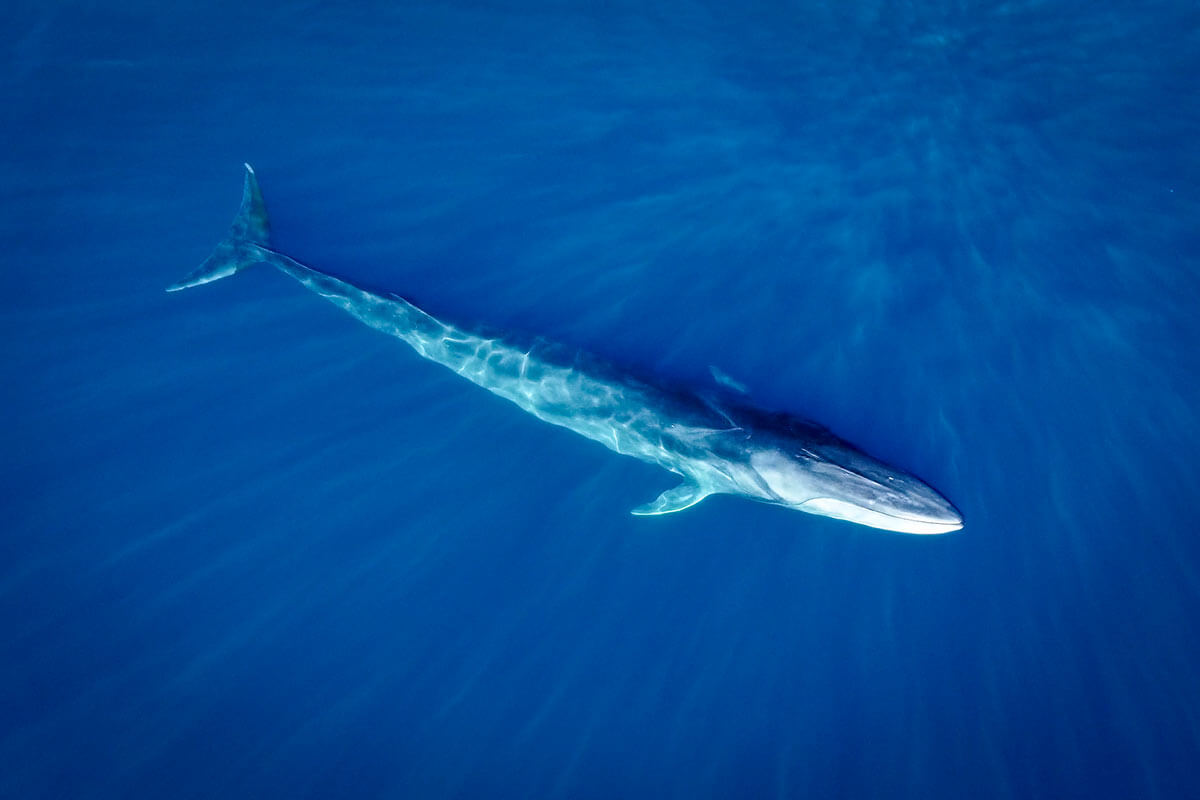9 Things That Are Amazing About Fin Whales

Fin whales are one of the many massive, majestic creatures that we see along the picturesque California coastline aboard Capt. Dave’s Dolphin and Whale Watching Safari. While they are found in many oceans all over the world, including the North Atlantic, North Pacific, Southern Ocean, and some parts of the Indian Ocean, these whales are considered a vulnerable species and are known to only be tens of thousands of them living today. In Dana Point, California, the Dolphin and Whale Watching Capital of the World®, we are lucky to see these magnificent creatures in their natural habitat, catching glimpses of them along their migratory journey. Read along for some amazing fin whale facts!
What is a Fin Whale?
The fin whale, or the Balaenoptera physalus, is a rorqual, along with its close relatives the humpback whale, blue whale, Bryde’s whale, sei whale, and minke whale (who are also frequent visitors to Dana Point!). The rorqual family of whales all have a dorsal fin and will expand their throat when feeding. Balaenoptera comes from the Greek word for fin and the Latin word for whale, while the name physalus comes from the Greek word for blow, referring to the fin whale’s blowhole, which will blow mist over 20 feet (6 meters) in the air.
Underwater Giants
One of the little-known fin whale facts is that not only is it the second largest whale in the world, but it is also the second largest animal to ever exist! The fin whale comes only second to the blue whale in size comparison. The fin whale will reach up to 85 feet long and can weigh up to 80 tons. That is the weight of 14 African elephants, the largest land mammal in the world, and longer than a 15-wheel semi-truck. A baby fin whale is born at 18 feet long, the height of an adult giraffe.
The expansive depth of the ocean and their abundant supply of food provide for the fin whale’s impressive magnitude. Despite their size, fin whales have evolved to be agile and streamlined in the water. Their V-shaped nose and elongated body help them navigate thousands of miles every year, travel up to 23 miles per hour, and dive up to 2,000 feet in search of food.
Feeding Frenzy
Eating an average of 2 tons a day, the fin whale travels far and wide to feast on krill, small fish, and squid. Fin whales are opportunistic feeders, meaning when there is food, they will follow it. Lucky for those aboard Capt. Dave’s Dolphin and Whale Watching Safari, these food sources are abundant along the coast of Dana Point, attracting fin whales and their hungry under-water friends.

An interesting fin whale fact is that these whales hunt by plunging with their mouths open into large schools of their prey. Fin whales use baleen, a structure in their mouth made of keratin that looks like giant bristles, like a filter to catch their prey and filter out the seawater before they swallow. The fin whale is also able to expand their mouth and throat with their accordion-like pleats to catch a massive amount of food at once.

Migratory Marvels
Like most whales, fin whales are migratory and travel thousands of miles every year to eat, mate, and give birth. In the summer months, fin whales tend to travel to higher latitudes, and colder water, attracted by the abundance of food in these areas. In the winter months, the fin whales will migrate to more temperate, tropical climates to mate and give birth to baby fin whales.
While it is a known fact that the fin whale migrates, little is known about the exact location where these mammals give birth since they tend to disperse into deeper waters to mate and calve. Dana Point’s vast underwater canyons and ridges make it a frequent destination for these giants during their seasonal migrations.
Choral Connection
A fascinating fin whale fact is that they can communicate underwater with each other using a variety of low-frequency moans and pulses that can travel up to 520 miles (850 km). These sounds are used to communicate with fellow fin whales over long distances, to find a mate, and as echolocation in search of food. Males have been known to project a series of pulses every 7-40 seconds for up to 10 hours. Many of these low-frequency sounds are extremely loud underwater, but not at a frequency that is audible to humans. These “songs” are used for communication with other whales only, not to find food like their toothed-whale relatives.
An incredible fin whale fact is that these oceanic creatures, like all baleen whales, do not have vocal cords. Instead, they use a unique sack-like structure that connects to their lungs to move air back and forth to produce sound. This allows the whale to “sing” without losing any precious oxygen. Fin whales and blue whales are known to have some of the most powerful calls on earth.

Distinct Hue
A unique fin whale fact is that they have asymmetric coloration on their mouths. Their lower right jaw is light in color while their lower left is dark. This coloration is thought to have evolved as an advantage to hunting their food, as a form of camouflage.
Another color adaptation that is common in most animals is countershading. The countershading of a fin whale manifests as a dark brownish gray upper side and white on the belly. This color placement is advantageous because, from the top, the fin whale blends with the deep ocean water, and from below the light belly blends in with the bright sky at the surface.
Facilitators of Photosynthesis
Did you know that just like plants on land, there are living organisms in the ocean that photosynthesize and convert CO2 into oxygen? The ocean is the earth’s largest “carbon sink” and provides more than 50% of the oxygen that we breathe. Migratory whales, like the fin whale, play a vital role in helping this conversion occur.
Most of the oxygen produced comes from phytoplankton, a microscopic species that is abundant in oceans all over the world. These phytoplankton feed on nutrients that are provided through fin whales diving deep and resurfacing, bringing nutrient-rich water to the surface for phytoplankton to feed on. Whale feces is also very nutrient-rich and provides food for phytoplankton to thrive.
The paramount fin whale fact is their beautifully balanced symbiotic relationship, the whale feeding the phytoplankton, in turn giving the whale oxygen to breathe. This phenomenon also helps in the fight against climate change, as the phytoplankton eliminate 40% of carbon produced in the atmosphere every year, which is 4 times more than the Amazon rainforest.

Conservation Concerns
One unfortunate fin whale fact is that like many marine species, fin whales face many threats due to human activity. Fin whales were valuable to hunt back in the day of heavy commercial whaling in the 19th and 20th centuries. Their numbers in the Southern Hemisphere dwindled to 1-2% of their original numbers as a result and were listed as an endangered species in 1970 under the Endangered Species Conservation Act. Their numbers are now reportedly increasing, and in 2018 they were updated on the IUCN red list as a vulnerable species.
Fin whales also face threats like getting tangled in commercial fishing gear, being struck by ships, noise pollution, climate change, loss of habitat, and water pollution. All of these things, as a result of human activity, affect the whales’ behavior and migration patterns, if not resulting in death. As a part of the delicate, interwoven ecosystem of the earth’s sea and land, this has a ripple effect on every other species involved, including humans.
Fin Whale Protection
Thanks to years of research and observation, we now understand what a wonderful creature the fin whale is and how vital it is to protect it! There are many efforts in place to protect the fin whale and other threatened species like it. We now have marine protected areas, including Dana Point, in places where fin whales frequent and thrive. Whaling of fin whales is prohibited under international agreements, and there has also been development of whale-safe fishing gear. There are even regulations set in place to reduce noise and water pollution.
A super awesome fin whale fact is that they are worth more economically alive than they are when hunted because of the growing popularity of whale watching! Whale watching companies like Capt. Dave’s provides jobs to many and supports the growth in education and admiration for the ocean and all that lives in it. Seeing the whales in their natural habitat promotes appreciation and motivation to protect them and the ocean as a whole. If you’re considering a whale watching cruise to see fin whales and more, discover the best time to whale watch in Southern California.
See the Fin Whale in the Wild!
Lucky for us, the fantastic fin whale can be seen in all its glory aboard Dana Point whale watching cruises. These amazing animals are just one of many sights to behold in Dana Point, the World’s Whale Capital®. Book a private charter or a public safari with us today for a chance to impress our crew with your knowledge of fin whale facts, catch a glimpse of these amazing animals, and share a world-class whale-watching experience with your family and friends!
Until next time,
Jaida James
